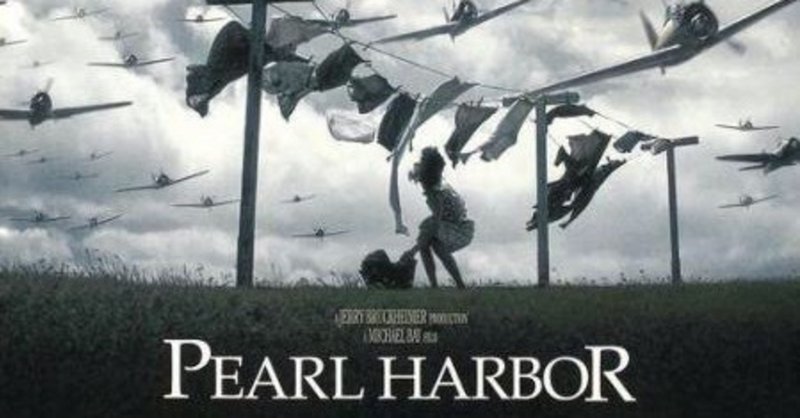
パールハーバーの欺瞞 アメリカ人が求めた真実⑷
シリーズ最終回です。真珠湾攻撃の真実を追い求めた元海軍写真部隊兵にして後にジャーナリストとなり、17年に渡る執念の調査を元に一冊の本を書き上げたロバート・D・スティネット。戦争を始める大義のために真珠湾で散った約3,000人の兵士たち。日本の攻撃を予見しつつ知らせなかったルーズベルト元大統領への糾弾は悪意のメディアから執拗な攻撃を受けました。
第一回のリンクはこちら
元サイト:インデペンデント誌 2002年12月2日
Captain A. James McCollum, USNR (Ret), who served in San Francisco’s Twelfth Naval District intelligence office (and later on the intelligence staff of Fleet Admiral Chester Nimitz) accused Kahn of committing “journalistic crimes.” “That critic, David Kahn, seems to have deliberately distorted some facts and even altered quotations...,” McCollum wrote in his letter to the editors of the NYRoB on February 14, 2001. The letter was never published.
サンフランシスコ第12海軍区情報局(後のチェスター・ニミッツ艦隊提督の情報参謀部)に勤務したA・ジェームズ・マッコーラム大尉(米国防総省退役軍人)はカーンの "ジャーナリズム犯罪 "を告発した。マッコーラム氏は2001年2月14日、NYレビューの編集者に宛てた手紙の中で、「評論家デビッド・カーンは、意図的に一部の事実を歪曲し、引用の内容まで変えたようだ。」と書いている。しかしこの手紙が一般公表されることはなかった。
Stephen Budiansky continued his media blitz in the Wall Street Journal. In a December 27, 2001 Letter to the Editor of the Journal, Budiansky praised Kahn as “...widely regarded as the world’s leading authority on the history of code breaking...” Then in following paragraphs, Budiansky mimicked Kahn and misreported the facts concerning the U.S. naval monitor station on Corregidor, known as CAST. He challenged the Day of Deceit account and wrote that CAST was located in Cavite, Philippines.
ステファン・ブディアンスキーは、ウォール・ストリート・ジャーナル紙を使って私の著書への攻撃を続けた。2001年12月27日付のウォール・ストリート・ジャーナル編集者への手紙で、ブディアンスキーはカーンを「...暗号解読の歴史における世界の第一人者として広く認められている...」と褒めそやした。その続きで、ブディアンスキーはカーンと同様に、CASTとして知られるコレヒドールの米海軍監視局に関する事実を歪曲した。彼はDay of Deceitの私の説は誤りだと指摘し、CASTはフィリピンのカビテにあると書いたのだ。
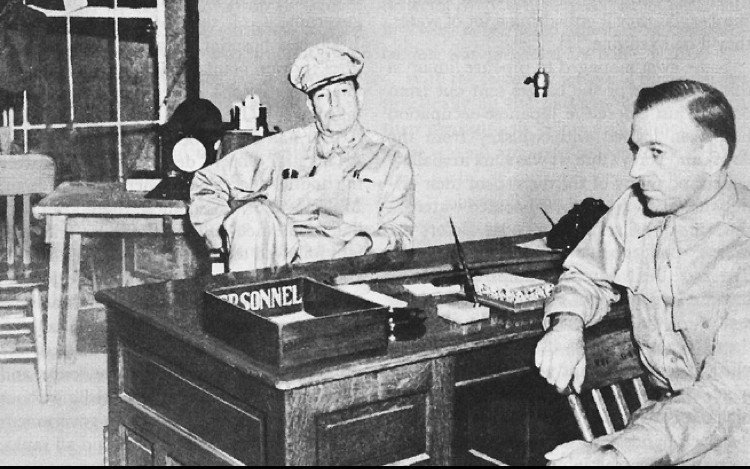
マッカーサー元帥(正面) 1942年3月1日、フィリピンコレヒドール、マリンタトンネル内海軍本部にて Wikipediaより引用
Budiansky’s errors involving CAST reveal a poor understanding of U.S. naval communications intelligence operations. CAST was temporarily located at the Cavite Naval Base in 1936, then moved to Mariveles on the Bataan Peninsula. In October 1940, the station was relocated to Corregidor. The new quarters were located in an underground crypto center carved from the rock of Corregidor. CAST remained on the rock until the spring of 1942 when advancing Japanese troops forced its removal to Australia. Budiansky did not differentiate between the 1940-41 U.S. naval broadcast radio center at Cavite and the U.S. navy cryptographic monitor station on Corregidor.
CASTを含むブディアンスキーの様々な誤りは、米国の海軍通信諜報活動に対する理解不足を露呈している。CASTは1936年にカビテ海軍基地に一時的に配置された後、バターン半島のマリベレスに移転した。1940年10月、さらにコレヒドールに移転した。新しい本部は、コレヒドールの岩を削って造られた地下の暗号センターに置かれた。CASTは1942年の春、日本軍の進撃によりオーストラリアへの撤去を余儀なくされるまでずっとそこに存在したのだ。ブディアンスキーは、1940-41年にカビテにあった米海軍放送ラジオセンターとコレヒドールにあった米海軍暗号監視局を区別できていなかったのだ。
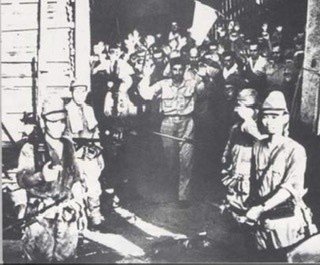
日本軍に投降し、コレヒドールのマリンタトンネルを出る米軍兵 1942年5月6日 Wikipediaより引用
The mistakes of the Budiansky-Drea-Kahn team concerning Station CAST worsen.
In the same Wall Street Journal edition, Edward J. Drea, a retired U.S. Army historian, also wrote a misleading account of the crypto operations at CAST in November 1941. Mr. Drea challenged a CAST report dated November 16, 1941, by its commanding officer Lieutenant John M. Lietwiler who reported to Washington that his staff was “current” in intercepting, decoding, and translating the Japanese navy’s Operation Code.
ブディアンスキー、ドレア、カーンらのCAST基地に関する誤謬はさらに酷くなる。
同ウォール・ストリート・ジャーナル紙上で、退役米陸軍の歴史家エドワード・J・ドレア氏も、1941年11月のCASTでの暗号作戦について、誤解を招く記述をしている。ドレア氏は、指揮官ジョン・M・リトワイラー中尉が1941年11月16日付けでワシントンへ送った、彼のチームが「現在」日本海軍の作戦暗号の傍受、解読、翻訳している、というCAST報告書に対して異議を唱えたのだ。
Lietwiler was a highly trained crypto expert in deciphering the Japanese navy’s main operation code known to Japan in the fall of 1941 as the Kaigun Ango-sho D, Ransuhyo nana (Navy Code Book D, random numbers table seven). He spent 1940 and most of 1941 learning the principles of decoding Code Book D from Agnes Meyer Driscoll, the brilliant Chief Civilian Cryptanalyst for the U.S. Navy. Ms. Driscoll was the first American to discover the solution of Code Book D, soon after Japan introduced it in June 1939.
リトワイラー中尉は高度な訓練を受けた暗号の専門家で、1941年秋には「海軍暗号書D 乱数表7」として日本で知られている日本海軍の重要な作戦暗号を解読していた。彼は1940年から1941年の大部分を費やして、米海軍の優秀な一般市民暗号解読者チーフであるアグネス・メイヤー・ドリスコル氏からコードブックDの解読原理を学んだ。彼女は、日本が1939年6月にコードブックDを導入した直後に、コードブックDの解法を発見した第一号のアメリカ人だ。
Upon completing the Code Book D crypto course, Lietwiler was dispatched to CAST with the latest decoding details of Table Seven. He arrived and took command of CAST in September 1941. Lietwiler’s expertise and devotion to his crypto duty meant nothing to Drea. In his letter, Drea demoted Lieutenant Lietwiler and described him as a “1941 writer.”
コードブックDの暗号コースを修了したリトワイラー中尉は、乱数表7の最新の解読詳細を携えて1941年9月にCASTに派遣され指揮を執った。だが、リトワイラー中尉の専門知識と暗号業務への献身は、残念ながらドレアにとっては無意味なものでしかなかった。ドレアは手紙の中で、リトワイラー中尉を「1941年の小説家」と扱き下ろした。
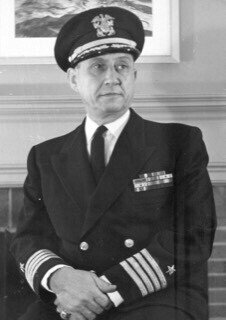
CAPTAIN JOHN MARION LIETWILER
UNITED STATES NAVY
April 15, 1908 – July 20, 1978
Challenging my interpretation of Lietwiler’s letter, Drea states: “Nowhere in the cited communications is the Japanese naval code mentioned.” Drea is correct in the narrowest sense. To understand that Lietwiler was discussing the Japanese naval operations code requires a broader context.
またドレアは、リトワイラー中尉の手紙に関する私の解釈に異議を唱え、「引用された通信のどこにも彼が言うような日本海軍コードに関する記述はない。」と述べた。ドレアの発言は、極めて狭義の解釈としては正しいが、実はリトワイラー中尉による日本海軍の作戦コード解読を理解するには、より広い背景知識が必要なのだ。
Mr. Drea failed to comprehend Lietwiler’s technical crypto language used in the letter. It was addressed to Lietwiler’s counterpart in Washington, D.C., Lieutenant Lee W. Parke, another of the U.S. Navy’s brilliant cryptographers. Parke had devised a crypto machine that automatically decoded the additive/subtractive columnar tables of Table Seven. Parke called his invention the JEEP IV and sent it to CAST by officer courier. It arrived on Corregidor on October 6, 1941, via the armed U.S. naval transport U.S.S. Henderson.
ドレア氏はリトワイラー中尉の手紙の中で使われた暗号解読の専門用語を理解していなかったのだ。この手紙は当時ワシントンD.C.で軍務にあたっていた、彼と同じく米海軍の優秀な暗号解読者の一人であったリー・W・パーク中尉に宛てたもので、パーク中尉は一般乱数表第七号の加法/減法の円柱表を自動的に解読する暗号機を考案した当人だ。パーク中尉は彼の発明品をJEEP4と名付け、将校専用配達でCASTに送り、1941年10月6日、武装米国海軍輸送船U.S.S.ヘンダーソン号に積まれコレヒドールに到着した。
The construction of JEEP IV was specifically authorized by Rear Admiral Royal Ingersoll, Acting Chief of Naval Operations. In a memo dated October 4, 1940, Ingersoll wrote, referring to Code Book D: “an additive key cipher is employed in this code, and, although the method of recovery is well defined, the process is a laborious one, requiring from an hour to several days for each message. A machine is under construction which will aide in the mechanical part of the solution, but it must be accepted that current information will seldom be available immediately...” The Ingersoll memo directly connects the Lietwiler memo to the Japanese naval operations code.
JEEP4の建造は、海軍作戦本部長代行のロイヤル・インガソル少将によって特別に許可された。1940年10月4日付けのメモに、インガソル少尉はコードブックDについて次のように書いている:「このコードには加法鍵暗号が採用されており、復元方法は上手く定義されているが、そのプロセスは手間のかかるものであり、各メッセージに 1 時間から数日を要する。 解読のメカニズムを補助する機械を作成中ではあるが、現在の情報がすぐに入手できないという欠点は否めない...」このインガソル少尉のメモこそ、リトワイラーの11月16日の手紙が、まさに日本海軍コードを指すものだと証明しているのだ。
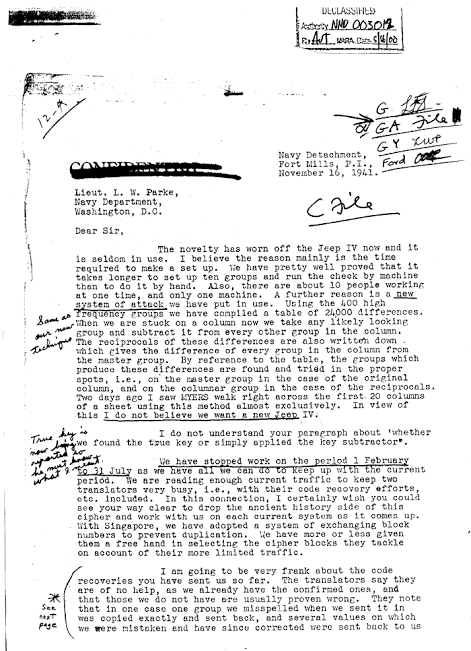
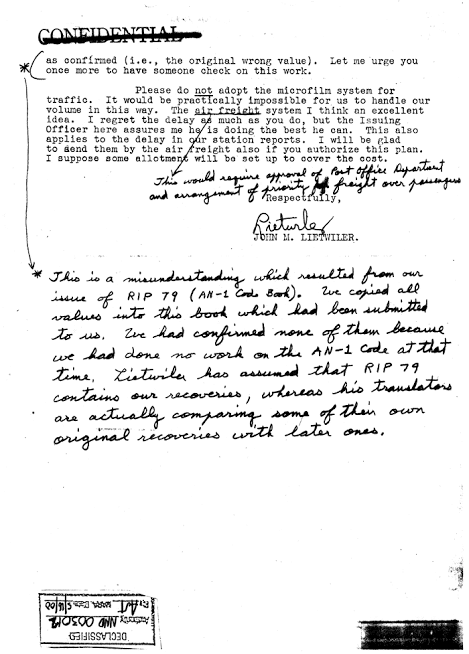
Letter from Lt. John Leitweiler, Commander of Station CAST, to Lt. Lee W. Parke, Chief, Japanese Cryptography Section, U.S. Navy November 16, 1941 (CAST基地指揮官リトワイラー中尉から米海軍日本軍暗号部パーク中尉への手紙)
Lietwiler refers explicitly to JEEP IV in the letter and adds that his Crypto Yeoman Albert Myers Jr., bypassed JEEP IV and was able to “walk across” the many columnar tables of Code Book D. Readers of the Wall Street Journal should know that Code Book D used columnar random number Table Seven in the fall of 1941. If Mr. Drea had done more crypto homework, he would have known the purpose of JEEP IV. It is fully spelled out in U.S. Navy files. JEEP IV is derived from Parke’s unit whose secret navy crypto designator was GYP (phonetic = jeep). But he failed to understand the esoteric language used by the two code breakers.
リトワイラー中尉は手紙の中でJEEP4にはっきりと言及している。彼の暗号解読下士官であるアルバート・メイヤーズJr. がこのJEEP4を使わずに、コードブックDの多柱状乱数表を「解読する」ことができたと付け加えた。ウォールストリートジャーナルの読者には、コードブックDが1941年の秋には一般乱数表第七号を使用していたことを知ってほしい。ドレア氏がもっと暗号について知識があれば、JEEP4の結末はわかったであろう。それは、米国海軍のファイルにしっかりと記述されている。JEEP4はパークの部隊から派生したもので、その部隊の海軍の極秘暗号デジグネータはGYP(表音文字=JEEP)だったのだ。しかし彼はこの2人の暗号解読者たちが手紙の中で使用した難解な用語を理解できなかったのだ。
I could point out more errors by the trio, but I will limit myself to one more. They refer to errors in dates in Day of Deceit. The so-called date “errors” they cite are not “errors” but are related to the geography of the International Date Line. Like many easterners who have never been west of the Hudson River, the trio does not realize that November 25 in Hawaii is November 26 in Japan. The mid-ocean date change between America and Japan is known throughout the world. It is the result of geographers establishing the Date Line in the Mid-Pacific. America’s day begins in Guam, not New York.
私はこの3名による間違いをもっと指摘することができるが、ここではあと一つにしておこうと思う。彼らは私の著書『Day of Deceit』の日付の誤りに言及している。彼らが引用しているいわゆる日付の "誤り "は "誤り "ではなく、これは国際日付変更線を隔てた位置に関係している。ハドソン川の西側に行ったことがない多くの東部人のように、この3名は、ハワイの11月25日が日本の11月26日であることに気付かなかったのだ。アメリカと日本の間の大洋中の日付変更は世界中で周知のことで、地理学者が中太平洋に日付変更線を設定した結果起こったのだ。アメリカの一日は、ニューヨークではなくグアムから始まるのだ。
(完)
